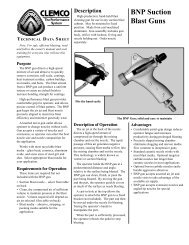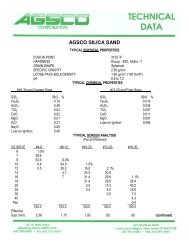material safety data sheet - All Categories On AGSCO Corporation
material safety data sheet - All Categories On AGSCO Corporation
material safety data sheet - All Categories On AGSCO Corporation
You also want an ePaper? Increase the reach of your titles
YUMPU automatically turns print PDFs into web optimized ePapers that Google loves.
MATERIAL SAFETY DATA SHEET<br />
Section 1<br />
Company Name: <strong>AGSCO</strong> <strong>Corporation</strong> Emergency number: 201-393-0300<br />
Address: 621 Route 46 West Information number: 201-393-0300<br />
Hasbrouck Heights, NJ 07604 Date prepared: October 1, 2009<br />
Product Name:<br />
Trap Rock<br />
Section 2<br />
Chemical analysis (typical)<br />
Elements %weight CAS # MSHA/OSHA PEL ACGIH TLV-TWA<br />
SiO<br />
2<br />
48 14808-60-07 (respirable) 10 mg/m³ /(% SiO<br />
2<br />
+ 2) 0.05 mg/m³<br />
Al<br />
2<br />
O<br />
3<br />
14.4 1344-28-1 (total) 15 mg/m³,(respirable) 5 mg/m³ *10 mg/m³<br />
Fe<br />
2<br />
O<br />
3<br />
15.1 1309-37-1 10 mg/m³ 5 mg/m³<br />
CaO 6.18 1305-78-8 5 mg/m³ 2 mg/m³<br />
MgO 5.95 1309-48-4 15 mg/m³ 10 mg/m³<br />
Na O<br />
2<br />
4.05 1313-59-3 - 2 mg/m³ as NaOH<br />
TiO<br />
2<br />
2.29 13463-67-7 15 mg/m³ 10 mg/m³<br />
K<br />
2<br />
O 2.29 12136-45-7 - -<br />
Others 1.74<br />
* : particulate matter containing no asbestos and < 1% crystalline silica<br />
PEL: Permissible exposure limit<br />
TLV-TWA: Threshold limit value – Time weighted average<br />
Section 3<br />
Physical properties<br />
Physical state:<br />
Solid<br />
Color:<br />
Grey<br />
Grain shape:<br />
Angular<br />
Hardness:<br />
6-6.5 MOHS<br />
Specific gravity: 2.90<br />
Density:<br />
102 lbs/ft³<br />
Odor:<br />
None<br />
Evaporation rate: N/A<br />
Water solubility: Negligible (approx. 0.75%)<br />
Compressive strength: 28 000 psi<br />
Section 4<br />
Reactivity <strong>data</strong><br />
Stability: Stable under normal condition of use, storage and transportation.<br />
Conditions to avoid: Avoid contact with incompatible <strong>material</strong>s (see next page).<br />
Incompatibility (<strong>material</strong>s to avoid): Trap rock ignites on contact with fluorine and is imcompatible with<br />
acids, alum, ammonium salts and magnesium. Silica reacts violently with powerful oxidizing agents such<br />
as fluorine, boron trifluoride, manganese trifluoride and oxygen difluoride yielding possible fire and/or<br />
explosions. Silica dissolves readily in hydrofluoric acid producing a corrosive gas - silicon tetrafluoride.<br />
Hazardous Decomposition products: None known<br />
Hazardous Polymerization: Not known to polymerize
Section 5<br />
Fire and explosion <strong>data</strong><br />
Flashpoint (Method used): Not flammable<br />
Flammable limits in air: Not flammable<br />
Extinguishing agents: None required<br />
Unusual Fire and Explosion Hazards: Contact with powerful oxidizing agents may cause fire<br />
and/or explosions (see section 4 of this MSDS).<br />
Section 6<br />
Preventive measures<br />
Personal protection and controls<br />
Respiratory protection: For respirable quartz levels that exceed or are likely to exceed an 8-hr TWA of 0.1<br />
mg/m³, a NIOSH approved dust respirator is recommended. For respirable quartz levels that exceed or are<br />
likely to exceed an 8-hr TWA of 0.5 mg/m³, a NIOSH approved HEPA filter respirator is recommended. If<br />
respirable quartz levels exceed or are likely to exceed an 8-hr TWA of 5 mg/m³, a NIOSH approved<br />
positive pressure, full face respirator or equivalent is recommended. Respirator use must comply with<br />
applicable MSHA or OSHA standards, which include provisions for a user-training program, respirator<br />
repair and cleaning, respirator fit testing and other requirements.<br />
Ventilation: Local exhaust or general ventilation adequate to maintain exposures below appropriate<br />
exposure limits.<br />
Skin protection: See «Hygiene» section below.<br />
Eye protection: Safety glasses with side shields should be worn as minimum protection. Dust goggles<br />
should be worn when excessively (visible) dusty conditions are present or are anticipated.<br />
Hygiene: Wash dust-exposed skin with soap and water before eating, drinking, smoking and using toilet<br />
facilities. Wash work clothes after each use.<br />
Other control measures: Respirable dust levels should be monitored regularly. Dust and quartz levels in<br />
excess of appropriate exposure limits should be reduced by all feasible engineering controls, including (but<br />
not limited to) wet suppression, ventilation, process enclosure and enclosed employee work stations.<br />
Spill, leak and disposal practices<br />
Steps to be taken in case <strong>material</strong> is released or spilled: The personal protection and controls identified<br />
above in this section should be applied as appropriate. Spilled <strong>material</strong>, where dust can be generated, may<br />
overexposed cleanup personnel to respirable crystalline silica-containing dust. Wetting of spilled <strong>material</strong><br />
and/or use of respiratory protective equipment may be necessary. Do not dry sweep spilled <strong>material</strong>.<br />
Prevent spilled <strong>material</strong>s from inadvertently entering streams, drains or sewers.<br />
Waste disposal method: Pick up reuse clean <strong>material</strong>s. Dispose of waste <strong>material</strong>s only in accordance with<br />
applicable federal, provincial and local laws and regulations.<br />
Storage and handling precautions<br />
Respirable crystalline silica-containing dust may be generated during processing, handling and storage.<br />
The personal protection and controls identified above in this section should be applied as appropriate. Do<br />
not store near food and beverages or smoking <strong>material</strong>s.<br />
Section 7<br />
Toxicological properties<br />
Exposure limits: see Section 2<br />
Primary route of exposure: Inhalation<br />
Acute toxicity<br />
Eye contact: Direct contact with dust may cause irritation by mechanical abrasion.
Skin contact: Direct contact may cause irritation by mechanical abrasion.<br />
Skin absorption: Not expected to be a significant exposure route.<br />
Ingestion: Expected to be practically non-toxic. Ingestion of large amounts may cause gastrointestinal<br />
irritation and blockage.<br />
Inhalation: Dusts may irritate the nose, throat and respiratory tract by mechanical abrasion. Coughing,<br />
sneezing and shortness of breath may occur following exposures in excess of appropriate exposure limits.<br />
Medical conditions aggravated by exposure<br />
Inhaling respirable dust and/or crystalline silica may aggravate existing respiratory system disease(s) and/or<br />
dysfunctions. Exposure to dust may aggravate existing skin and/or eye conditions.<br />
Chronic toxicity<br />
Prolonged and repeated inhalation of respirable crystalline silica-containing dust in excess of appropriate<br />
exposure limits has caused silicosis, a lung disease. Not all individuals with silicosis will exhibit symptoms<br />
(signs) of the disease. However, silicosis can be progressive and symptoms can appear at any time, even<br />
years after exposure has ceased. Symptoms of silicosis may include, but are not limited to: shortness of<br />
breath, difficulty breathing with or without exertion, coughing, diminished work capacity, diminished chest<br />
expansion, reduction of lung volume, right heart enlargement and/or failure. Smoking may increase the<br />
risk of developing lung disorders, including emphysema and lung cancer. Persons with silicosis have an<br />
increased risk of pulmonary tuberculosis infection.<br />
Carcinogenicity<br />
Trap rock is not listed as a carcinogen by International Agency for Research on Cancer (IARC), the<br />
National Toxicology Program (NTP), or the Occupational Safety and Health Administration (OSHA). In<br />
October 1996, an IARC Working Group re-assessing crystalline silica, a component of this product,<br />
designated crystalline silica as carcinogenic (Group I). The NTP’s Report on Carcinogens, 9 th edition, lists<br />
respirable crystalline silica as a «known human carcinogen». In year 2000, the American Conference of<br />
Governmental Industrial Hygienists (ACGIH) listed respirable crystalline silica (quartz) as a suspected<br />
human carcinogen (A-2). These classifications are based on sufficient evidence of carcinogenicity in<br />
certain experimental animals and on selected epidemiological studies of workers exposed to crystalline<br />
silica.<br />
Section 8<br />
First Aid<br />
Eyes: Immediately flush eye(s) with plenty of clean water for at least 15 minutes, while holding the<br />
eyelid(s) open. Occasionally lift the eyelid(s) to ensure thorough rinsing. Beyond flushing, do not attempt<br />
to remove <strong>material</strong> from eye(s). Contact a physician if irritation persists or later develops.<br />
Skin: Wash with soap and water. Contact a physician if irritation persists or later develops.<br />
Ingestion: If person is conscious, give large quantity of water and induce vomiting; however, never attempt<br />
to make an unconscious person drink or vomit. Get immediate medical attention.<br />
Inhalation: Move the fresh air. Dust in throat and nasal passages should clear spontaneously. Contact a<br />
physician if irritation persists or later develops.<br />
Section 9<br />
Disclaimer<br />
The information contained in this <strong>material</strong> <strong>safety</strong> <strong>data</strong> <strong>sheet</strong> was obtained from sources that <strong>AGSCO</strong><br />
<strong>Corporation</strong> believes to be reliable. However <strong>AGSCO</strong> <strong>Corporation</strong> makes no guarantee, representation or<br />
warranty as to the correctness or accuracy of the information. The information in this MSDS is intended as<br />
a guide to be used in <strong>safety</strong> training and education. It is the responsibility of the user to provide a safe<br />
workplace, and to determine if precaution in addition to those described herein, are required. Compliance<br />
with all applicable federal, provincial, state and local laws and regulations are the responsibility of the user.<br />
The user assumes all risks and liability for any use. <strong>AGSCO</strong> <strong>Corporation</strong> does not assume responsibility<br />
and disclaim liability to any losses, damages or expenses associated with the use of these products.















